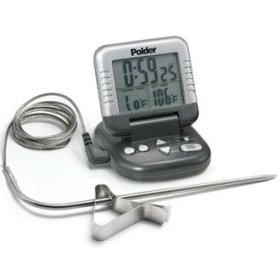
|
|
SUBSIM: The Web's #1 resource for all submarine & naval simulations since 1997
 |
SUBSIM: The Web's #1 resource for all submarine & naval simulations since 1997 |
|
|
 01-22-11, 09:14 PM
01-22-11, 09:14 PM
|
#1 |
|
Captain
 Join Date: Sep 2008
Location: Southeastern USA
Posts: 546
Downloads: 1
Uploads: 0
|
Here in the southeastern US we call what you are referring to as a "BBQ" a grill.
BBQ is a well-known food you sometimes cook on your grill. Funny how the same words mean something different depending on where you are. As to our grill, I don't use charcoal but short sections of wood from either pecan or hickory as we have those here in abundance in the woods, saves lots of money you can spend on meat instead. |

|

|
 01-22-11, 09:33 PM
01-22-11, 09:33 PM
|
#2 |
|
Navy Seal
 Join Date: Mar 2007
Location: New Mexico, USA
Posts: 9,023
Downloads: 8
Uploads: 2
|
I'd say to be BBQ it would have to be with a lid (closed), and smoke would be part of the equation.
I don't consider a steak as BBQ, frankly, not unless you cook it long enough that the smoke really matters. |

|

|
 01-22-11, 09:46 PM
01-22-11, 09:46 PM
|
#3 | |
|
Ocean Warrior
 Join Date: Aug 2007
Location: Montreal, Canada
Posts: 2,983
Downloads: 102
Uploads: 1
|
Hah, what I meant by BBQ is the cooking tool.
As I live in an apartment, in the middle of a snow clogged city, getting wood to burn isnt really an option for me on a student budget. Tater, what does leaving the steak out of the fridge for an hour do compared to taking it out of the freezer the night before (setting it in fridge over night) and then taking it out, salting it and then putting it on the grill/bbq/whatever you like to call it? Also, what does resting the meat for 5 minutes after cooking do? This time, when I cut into the steak there was no blood. But, for example, I pan fried sausages last night for dinner and they had juice come out when I was eating them.
__________________
Quote:

|
|

|

|
 01-22-11, 10:09 PM
01-22-11, 10:09 PM
|
#4 |
|
Navy Seal
 Join Date: Mar 2007
Location: New Mexico, USA
Posts: 9,023
Downloads: 8
Uploads: 2
|
The critical thing is the temp inside BEFORE you cook. If you take the steak from the fridge and cook, by the time the center is the right temp, the outside will be wrecked. The goal is the perfect crust, and as much of the inside the same target temp as possible. Room temp is closer to target temp than a fridge (which is ~37° F).
Resting is critical. When you cook, the juices are driven away from the heat. When the steak rests, the heated water equilibrates and spreads more evenly around the meat. The result is more moist bits of meat (all the fluids that cover the plate/cutting board are NOT in the meat, obviously. Rested meat doesn't bleed, all that goodness is in the meat. Always rest meat. Always. |

|

|
 01-22-11, 10:14 PM
01-22-11, 10:14 PM
|
#5 | |
|
Ocean Warrior
 Join Date: Aug 2007
Location: Montreal, Canada
Posts: 2,983
Downloads: 102
Uploads: 1
|
Awesome, thank you for the tip Tater, I wasn't aware of that
Edit: And as for room temp; I thought it was as long as it wasn't frozen, or have bits meat still frozen inside, it was good.
__________________
Quote:

|
|

|

|
 01-22-11, 11:09 PM
01-22-11, 11:09 PM
|
#6 |
|
Navy Seal
 Join Date: Mar 2007
Location: New Mexico, USA
Posts: 9,023
Downloads: 8
Uploads: 2
|
Say you want rare. The very center would be ~120°F (~49°C). If the steak was 40°F at the center (fridge temp), you have to raise that bit 80°. The trouble is that since the heat is coming from the outside, the outside gets crisped while the center slowly heats.
What you see when you cut such a steak is the crust on the outside (which is very well done, obviously, then grey, well done meat surrounding our rare center. The trouble is that it has taken so long to get the center to 120 that the "rare" bit of your 1.5" thick steak is almost not there. In fact, the bulk of the steak is well or medium well, and only a sliver in the middle is well. A "perfect" rare steak would have a great crust (again, the crust is very well done), but the crust would be VERY thin, and the entire interior would be a uniform 120°. 1.25" of red, rare steak, and 1/8 of an inch of crust all around. If you start with the steak at room temp (~70°F), the very center only needs to rise 50°. This radically improves your chances of having the bulk of the middle fall in the rare range (~120-125°), with a thin crust. With any cooking method, you'd be very well served to get a probe thermometer with a temp alarm (under $20). Set the temp alarm to 5°F below your target temp. So 115 for rare (120 final temp after resting), 121° for medium rare (126 target temp), 131° (135 final) for medium. I'd not worry about well, there is no "perfect way to ruin meat. Above medium anything is ruined enough to be "well done." (anyone who orders well-done in a restaurant should reconsider eating out, or order something else. In restaurants, they typically save the worst pieces of meat for "well" since no one ordering well can tell the difference anyway (the best cut cooked well tastes no better than the worst). Use the probe. Cook enough on your grill or pan, (ideally try for the same thickness of steak every time, it makes it WAY easier to learn), and you'll be able to do it by time and feel (press meat with finger and watch for the way it rebounds—but this take a load of practice with similar pieces of meat to get right). When I cook for guests, I always use a probe on one steak as a guide so I get them right. If I have rare, MR, and M that people want, I set it for rare (all steaks look the same thickness wise), then pull the rares when it goes off leaving the probed steak as the most done. I then reset it for medium rare, and pull those when it hits 121. Then medium last. I don't cook steaks for friends that like ruined (don't have any, actually That make sense? |

|

|
 01-22-11, 11:14 PM
01-22-11, 11:14 PM
|
#7 | |
|
Ocean Warrior
 Join Date: Aug 2007
Location: Montreal, Canada
Posts: 2,983
Downloads: 102
Uploads: 1
|
Makes a ton of sense
Thanks a lot tater, steaks tomorrow, take #2  If I ever go to a subsim meet I'll have to thank you personally If I ever go to a subsim meet I'll have to thank you personally 
__________________
Quote:

|
|

|

|
 01-22-11, 11:38 PM
01-22-11, 11:38 PM
|
#8 |
|
Navy Seal
 Join Date: Mar 2007
Location: New Mexico, USA
Posts: 9,023
Downloads: 8
Uploads: 2
|
Probe thermo (same I have):
 This will save your butt, and take the guesswork out. On steaks, since they are sorta thin, I stick in in from the side dead center. Do this and you can't go wrong in terms of target doneness (115—R, 121—MR, 131—M, >131—ruined My fave cut is rib-eye, and thick. When you have think steaks, you need to finish them slow if you sear first ("searing in juices" is BS, you can sear last, too—which is another way to cook, slowly raise center to target, then a quick, hot sear). I have seared on blazing hot cast iron for ~2 minutes on the first side, then flip, 1 minute on heat, then chuck in oven til probe goes off. The slow method is to set the burner (or grill) to ~340° (I have an infrared thermo (laser) I got at Lowes), then cook all sides (thick steak so you cook the SIDES, too) at lower temp. Same deal, visually cook outside for "sear" and use the probe to decide when it is done. People who can cook steaks without "aids" and can hit proper doneness I give props too. I have to cheat and use the probe most of the time |

|

|
 |
|
|
